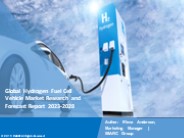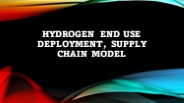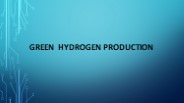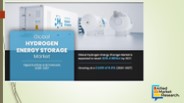Hydrogen Demand PowerPoint PPT Presentations
All Time
Recommended
The adoption of U.S. Europe And Asia Industrial Hydrogen Market cells is on the rise across various industries such as automotive, power generation, and stationary power applications. Industrial hydrogen is essential for the efficient functioning of these fuel cells. The growing investment in research and development activities to enhance the performance and reduce the cost of hydrogen fuel cells is boosting the demand for industrial hydrogen.
| PowerPoint PPT presentation | free to download
In North America, the Hydrogen Price were surging during the fourth quarter of 2021, backed by high upstream cost. Hydrogen is mainly produced through steam methane refining process in the US, and the prime source of methane there is natural gas. Since the prices of natural gas was inclining, the price value of methane soared, eventually contributing towards price hike of Hydrogen. Furthermore, the strong demand from the market also supported the upward trajectory of Hydrogen prices. Furthermore, demand fundamentals for the product remained overall stable throughout the quarter, while inflationary pressure kept on concerning the manufacturers.
| PowerPoint PPT presentation | free to download
The UK green hydrogen market is projected to exhibit a growth rate (CAGR) of 36.50% during 2024-2032.
| PowerPoint PPT presentation | free to download
[191 Pages Report] The global hydrogen market is valued at USD 242.7 billion in 2023 and is projected to reach USD 410.6 billion by 2030; it is expected to record a CAGR of 7.8% during the forecast period. The growth in hydrogen demand in recent years is due to the increasing government focus on developing hydrogen-based economies and investment in the hydrogen infrastructure. The market for hydrogen is projected to benefit greatly from the rising usage of low emission fuel.
| PowerPoint PPT presentation | free to download
The Business Research Company offers Hydrogen Generation market research report 2023 with industry size, share, segments and market growth
| PowerPoint PPT presentation | free to download
Global hydrogen fuel cell vehicle market size is expected to reach $20.52 Bn by 2028 at a rate of 20.5%, segmented as by vehicle type, commercial vehicle, passenger cars
| PowerPoint PPT presentation | free to download
TBRC global hydrogen compressor market report includes oil & gas, chemical, utility, refueling stations, others
| PowerPoint PPT presentation | free to download
According to the latest research report by IMARC Group, The Saudi Arabia hydrogen generation market size is projected to exhibit a growth rate (CAGR) of XX% during 2024-2032. More Info:- https://www.imarcgroup.com/saudi-arabia-hydrogen-generation-market
| PowerPoint PPT presentation | free to download
https://www.share.net/imarc123/united-states-hydrogen-peroxide-market-ppt-demand-trends-and-business-opportunities-202328
| PowerPoint PPT presentation | free to download
A new report available with decisiondatabases.com on Hydrogen Market which provides an in-depth analysis during the forecast period. This report focuses on top manufactures with capacity, production, price, revenue and Market share.
| PowerPoint PPT presentation | free to download
The global hydrogen powered transport market size is expected to grow from $3.27 billion in 2021 to $5.15 billion in 2022 at a compound annual growth rate (CAGR) of 57.5%.
| PowerPoint PPT presentation | free to download
According to the latest research report by IMARC Group, The global hydrogen fuel cell vehicle market size reached US$ 1,130.9 Million in 2022. Looking forward, IMARC Group expects the market to reach US$ 12,324.9 Million by 2028, exhibiting a growth rate (CAGR) of 45.11% during 2023-2028. More Info:- https://www.imarcgroup.com/hydrogen-fuel-cell-vehicle-market
| PowerPoint PPT presentation | free to download
The hydrogen peroxide market is projected to expand 1.9x until 2026.
| PowerPoint PPT presentation | free to download
TBRC global hydrogen market report includes pipeline, high-pressure tube trailers, cylinders, chemical, refinery, metal processing, other applications
| PowerPoint PPT presentation | free to download
Hydrogen Demand and Resource Analysis (HyDRA) Project ... To access both the new and old HyDRA. https://rpm.nrel.gov/rpmentry and request a login ...
| PowerPoint PPT presentation | free to view
Global hydrogen generation market share from electrolysis process was over 7% of global revenue share in 2015 and is predicted to witness growth over 5% from 2016 to 2024.It is used to generate hydrocarbon from water through the application of electric current.
| PowerPoint PPT presentation | free to download
Big Market Research “Lead Hydrogen Arsenate Industry“ Size, Share, Industry Trends, Demand, Insights, Analysis, Research, Report, Opportunities, Company Profiles, Forecast
| PowerPoint PPT presentation | free to download
The hydrogen sensors market is estimated to reach at a value of US$ 388.0 Mn by the end of 2022 and expected to reach at a value of US$ 685.0 Mn by 2030 with a significant CAGR of 7.4%.
| PowerPoint PPT presentation | free to download
The report provides a basic overview of Hydrogen Peroxide industry including definitions, applications and industry chain structure. Global market analysis and Chinese domestic market analysis are provided with a focus on history, developments, trends and competitive landscape of the market. A comparison between the international and Chinese situation is also offered. Browse Full Report with TOC @ http://www.marketresearchstore.com/report/global-hydrogen-peroxide-urea-industry-2015-market-research-report-13997
| PowerPoint PPT presentation | free to download
... for automotive hydrogen storage systems ... Materials and accessories used shall be. compatible ... Fuel storage systems for vehicles require a fail-safe ...
| PowerPoint PPT presentation | free to view
The fairly consolidated global hydrogen electrolyzer market is estimated to grow at a steady pace of ~7% during the forecast period due to increasing demand for alkaline electrolyzers driving sales.
| PowerPoint PPT presentation | free to view
Increasing energy demand coupled with new oil and gas discoveries and technologies giving rise to alternate fuels (Biofuel) have had a direct affect on the fuel dispenser market
| PowerPoint PPT presentation | free to download
Hydrogen is produced when natural gas is heated with steam which produces syngas (mixture of carbon monoxide and hydrogen). Hydrogen can also be alternatively produced by electrolyzing water. Moreover, hydrogen can be generated from an extensive range of initial raw materials, including the most commonly used technology like steam reforming of natural gases. Request Sample @ https://www.marketresearchfuture.com/sample_request/7026
| PowerPoint PPT presentation | free to download
Energy and the New Reality, Volume 1: Energy Efficiency and the Demand for Energy Services Chapter 10: Energy Demand Scenarios L. D. Danny Harvey
| PowerPoint PPT presentation | free to download
hydrogen supply chain Understanding the Surge in Hydrogen Demand: Definition of Hydrogen as an Energy Carrier: Hydrogen, in the context of energy, serves as an energy carrier rather than a primary source of energy. It is a versatile and clean energy carrier that can store, transport, and deliver energy in various forms.
| PowerPoint PPT presentation | free to download
The green hydrogen market is driven by the faction like the development of electrolysis technologies, lowering the cost of producing renewable energy by all sources, and rising demand from FCEVs and the power industry. Therefore the green hydrogen market is estimated to reach the highest CAGR of 58.0% and is predicted to grow from $444 million to $4373 million by 2026. Get Free Sample Report @ https://www.businessworldeco.com/request-sample/56/
As governments and industries around the world commit to reducing carbon emissions and combating climate change, the demand for clean energy solutions like hydrogen continues to grow. Hydrogen plant manufacturers are poised to play a crucial role in meeting this demand by scaling up production and driving down costs through technological innovations.
| PowerPoint PPT presentation | free to download
Hydrogen has gained significant attention as a versatile and clean energy carrier, and developing countries are capitalizing on its potential due to several factors, including rapid industrialization, increasing energy demand, and abundant renewable energy resources.
| PowerPoint PPT presentation | free to download
Growing application as an alternative to fossil fuel and rise in demand for sustainable power source drive the growth of the global hydrogen energy storage market. On the other hand, high capital cost is expected to curb the growth to some extent. However, robust investment and government support are expected to create lucrative opportunities for the key players in the industry.
| PowerPoint PPT presentation | free to download
Hydrogen Energy Storage Market
| PowerPoint PPT presentation | free to download
In North America, the prices of Hydrogen were surging during the fourth quarter of 2021, backed by high upstream cost. Hydrogen is mainly produced through steam methane refining process in the US, and the prime source of methane there is natural gas. Since the prices of natural gas was inclining, the price value of methane soared, eventually contributing towards price hike of Hydrogen. Furthermore, the strong demand from the market also supported the upward trajectory of Hydrogen prices. Furthermore, demand fundamentals for the product remained overall stable throughout the quarter, while inflationary pressure kept on concerning the manufacturers.
| PowerPoint PPT presentation | free to download
The growing concern for the environment’s safety and rise in government initiatives are driving the market for liquid hydrogen market.
The deployment of hydrogen in end-use applications is expected to involve a combination of on-site clusters, co-production, and dedicated supply chain models. The specific approach will depend on factors such as the scale of hydrogen demand, industry requirements, infrastructure availability, and regional considerations.
| PowerPoint PPT presentation | free to download
hydrogen in various industries is projected to grow with a healthy compound annual growth rate (CAGR) of 5.48% during the forecast period of 2019 to 2025.
| PowerPoint PPT presentation | free to download
Leveraging Hydrogen Technologies for a Sustainable Future: Hydrogen, often hailed as the "fuel of the future," is making significant strides in the energy sector. As the world seeks more sustainable and environmentally friendly energy solutions, hydrogen has emerged as a key player in the transition to a cleaner and greener future. This article explores the various facets of hydrogen technologies, from production and storage to its applications in power generation, transportation, and industry. We'll also delve into the winning imperatives for businesses and technology companies looking to gain a competitive edge in the rapidly evolving hydrogen landscape.
| PowerPoint PPT presentation | free to download
Green hydrogen is a nontoxic, carbon-friendly gas produced by the splitting of water molecules into hydrogen gas through electrolysis, releasing oxygen as a byproduct. The process involves the passage of electric current through an electrolyzer. Green hydrogen is considered carbon-free; therefore, even the electricity utilized for electrolysis should be generated through renewable sources. Several global researchers & scientists concur that green hydrogen can emerge as a befitting solution to mitigate the burgeoning problem of global warming and help achieve a green gas-neutral economy by 2050. Click here to get better acquainted with our pivotal services. https://www.iebrain.com/events/carbon-capture-technology-expo-europe-and-hydrogen-technology-expo-europe/#meetus
| PowerPoint PPT presentation | free to download
Hydrogen has gained significant attention as a versatile and sustainable energy carrier, with numerous use cases across various sectors. In this response, we will explore the most lucrative use cases for hydrogen and highlight the sectors that are willing to pay a premium for its applications, specifically in chemicals and industry, automotive, and aerospace/defense.
| PowerPoint PPT presentation | free to download
TOP 10 HYDROGEN PRODUCTION COST OPTIMIZATION TECHNIQUES Hydrogen production cost analysis is crucial for understanding the economic viability of hydrogen as an energy source. But do you know what are those Cost Optimization techniques, how to identify, which phase to implement?
| PowerPoint PPT presentation | free to download
Hydrogen has gained significant attention as a versatile and sustainable energy carrier, with numerous use cases across various sectors. In this response, we will explore the most lucrative use cases for hydrogen and highlight the sectors that are willing to pay a premium for its applications, specifically in chemicals and industry, automotive, and aerospace/defense.
| PowerPoint PPT presentation | free to download
Hydrogen is a key energy carrier in the envisaged Hydrogen Future. Future energy systems will find hydrogen to be a beneficial component due to its many advantages. It is a flexible, clean energy source. Read More - https://www.marketsandmarkets.com/industry-practice/hydrogen/Hydrogen_Page.asp
| PowerPoint PPT presentation | free to download
The hydrogen future that is being envisioned includes hydrogen as a major energy carrier. Hydrogen has numerous benefits that will make it a useful component of future energy systems. This renewable energy source is adaptable.
| PowerPoint PPT presentation | free to download
Hydrogen Fuel Cell Market By Type (Proton Exchange Membrane Fuel cells, Phosphoric Acid Fuel Cells, Solid Oxide Fuel Cells, Molten Carbonate Fuel Cells, Others), By Application (Stationary, Transportation, Portable), By End User (Fuel Cell Vehicles, Utilities, Defense) and region (North America, Europe, Asia-Pacific, Middle East and Africa and South America)
| PowerPoint PPT presentation | free to download
The process of planning and overseeing the many tasks involved in the production, distribution, storage, and transportation of hydrogen in the most economical and efficient manner is known as Hydrogen Supply Chain optimization. Optimization is the process of locating and fixing inefficiencies, bottlenecks, and other obstacles that can prevent hydrogen from moving freely throughout the supply chain.
| PowerPoint PPT presentation | free to download
Explore the potential of green hydrogen plants in shaping the future of renewable energy. Learn how they contribute to a sustainable and eco-friendly world. Read more here!
| PowerPoint PPT presentation | free to download
Hydrogen is produced through electrolysis of water and the gas is stored in medium or large sized containers according to the requirements. The gas can be converted into energy in combustion engine or in fuel cell. Usually, hydrogen energy is stored in three form; liquid, solid, and gaseous form. To store hydrogen in gas form, it requires high high-pressure tanks, whereas it can be stored in liquid form only under cryogenic temperature. Hydrogen storage is widely used in fuel cell technologies for stationary power and transport applications.
| PowerPoint PPT presentation | free to download
The global hydrogen generation market is gaining significant traction because of the driving factors such as the shift towards sustainability, growing demand for clean and green fuel, and the flourishing hydrogen fuel cell vehicles industry. Hydrogen can be used in a variety of chemical and industrial processes, as well as integrated renewable energy systems and transportation to achieve zero or near-zero emissions. Furthermore, the wide application of hydrogen for converting heavy petroleum fractions into lighter ones via hydrocracking is another significant factor driving the demand for hydrogen generation.
| PowerPoint PPT presentation | free to download
The US market for Hydrogen Peroxide have showcased increase in prices throughout the first quarter of 2022 as the cleaning practices from end consumers improved which increased the demand for Hydrogen Peroxide as a cleaning agent. Prices during Q1 of 2022 were recorded around USD 678/MT. Prices of upstream crude oil as its supply remained disrupted globally on account of the conflict between Russia and Ukraine. As there was no improvement in the supply and imports of Hydrogen Peroxide, the traders in the American market began offering premiums in Hydrogen Peroxide offers during the first quarter of 2022.
| PowerPoint PPT presentation | free to download
The growing demand for less oil and diesel dependence and the increasing concern about emission control is driving the demand for the market.
| PowerPoint PPT presentation | free to download
MMO titanium anodes, cathodes, HHO Generator, Fuel Cell Kits, Dry Cell Kit , H2O statuary engines, fuel benefits pollution free exhaust, Water4gas, fuel saver, wate car, Hydrogen and Oxygen, Green Gas, Brown's Gas, Rhodes Gas, Bubbler, Hydrogen Generator, Water reservoir, dryer, Increase the Mileage, electrolyzer, Automobile, Power Battery, Cooling Systems, Transportation, Diesel, Gasoline, biodiesel engine.
| PowerPoint PPT presentation | free to view
Green Hydrogen market size is forecasted to reach US$2.4 billion by 2027, after growing at a CAGR of 14.1% during the forecast period 2022-2027.
| PowerPoint PPT presentation | free to download
Green hydrogen (GH) scaling faces several key problems that must be addressed before mainstream usage. Technology readiness and cost, infrastructure development, market off-takers, funding, supply chain constraints, and policy frameworks are among the challenges.
| PowerPoint PPT presentation | free to download
The Global Hydrogen Fuel Cell Recycling Market is expected to grow at a CAGR of 14.20% in terms of revenue, over the forecast period of 2024-2032. Read More
| PowerPoint PPT presentation | free to download
Integrating hydrogen end-use applications in industries such as automotive, marine, industrial, and aviation requires the development and deployment of hydrogen technologies specific to each sector. Here's an overview of how hydrogen can be integrated into these industries.
| PowerPoint PPT presentation | free to download
The process of planning and overseeing the many tasks involved in the production, distribution, storage, and transportation of hydrogen in the most economical and efficient manner is known as hydrogen supply chain optimization. Optimization is the process of locating and fixing inefficiencies, bottlenecks, and other obstacles that can prevent hydrogen from moving freely throughout the supply chain.
| PowerPoint PPT presentation | free to download
Emerging Techno-Commercially attractive Hydrogen Business Models - Hydrogen Generation, Hydrogen Storage, and Hydrogen Distribution. Hydrogen Generation: • Steam Methane Reforming (SMR): Steam Methane Reforming (SMR): SMR is currently the most common method for large-scale hydrogen production, accounting for the majority of global hydrogen supply. It involves reacting natural gas (methane) with steam to produce hydrogen and carbon dioxide. SMR is a mature technology and has well-established infrastructure. However, it is associated with greenhouse gas emissions unless carbon capture and storage (CCS) technologies are employed
| PowerPoint PPT presentation | free to download
According to the Market Statsville Group (MSG), the global hydrogen storage market size is expected to grow around USD 1,425.3 million by 2033, at a CAGR of 6.8% from 2023 to 2033. The Hydrogen Storage Market is witnessing rapid growth driven by increasing global demand for clean energy solutions. As hydrogen gains popularity as a sustainable fuel, effective storage technologies have become crucial.
| PowerPoint PPT presentation | free to download
























































